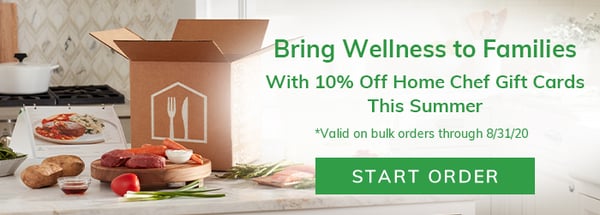Nutrition and health are closely related. According to the Office for Disease Prevention and Health Promotion, a poor diet is noted as a major contributing factor for a number of chronic diseases, including cardiovascular disease, cancer, and diabetes.
The consequences of chronic diseases are experienced across the board: they cost employers an average of $28.2 million every year in productivity loss from high rates of absenteeism and functional limitation, according to a study from the University of Arkansas for Medical Sciences, and 90% of the US’s healthcare expenditures are for people with chronic diseases, according to the Centers for Disease Control (CDC).
With millions of Americans experiencing hunger and malnutrition as a result of food insecurity, a major concern is lack of access to nutritional food and the effects it will have on people’s health. Being in the midst of a worldwide pandemic, food and nutritional wellbeing are more important than ever because of how families and individuals, especially those already at risk, are being affected by layoffs, working essential jobs, and accessing food while the stay-at-home and mask orders are in place.
Who’s At-Risk for Food Insecurity
Poor nutrition isn’t a recent issue: 40% of Americans went hungry in 2017 according to the US Department of Agriculture, and 15 million households were food insecure. “Food insecurity” is the lack of access to enough food for household members due to affordability and a lack of resources. Inner-city and rural residents often struggle to find nutritional food because there are limited or no grocery stores nearby and fresh produce is hard to find, something the Centers for Medicare & Medicaid also calls “Social Determinants of Health.” However, these are not the only populations who are struggling currently.
Today, individuals and families are facing additional hardships due to the COVID-19 pandemic. The Bureau of Labor Statistics reports that, as if June, the total number of new and continued unemployment claims now stands at over 19.3 million, meaning more individuals and families are likely struggling with basic necessities, including buying healthy food that supports their health and wellness.
COVID-19 has impacted individuals and families in other ways as well: for those now working remotely, being home doesn’t mean there’s free time to cook something healthy, especially for those who have other family members at home with them or don’t have access to childcare currently. Those who are not working remotely, including essential workers, often struggle to find the time to find recipes and prepare meals after working all day and commuting.
Another concern is that experiencing food insecurity at a young age can lead to lasting health concerns—especially if families facing hunger are forced to choose between spending money on food or necessary expenses, such as rent and utilities. Many nonprofits and managed care organizations use incentives to encourage preventive care and reduce the cost of medical expenses in wellness programs, and the same incentives can be used for people facing food insecurity and malnutrition.
Studies Show that Incentives Improve Health
Incentives have proven to be effective at motivating populations to make healthier choices, including participating in wellness programs and regular health screenings.
A study by Rand Health shows that employers who use incentives for health screening activities report significantly higher participation rates than those who don’t, and that incentives for health risk assessments are particularly effective above the threshold of $50. On average, they estimate that an increase in the incentives by $10 is associated with a 1.6 percentage point increase in health risk assessment completion rate for incentives in the range of $0-$100.
Research indicates that incentives can also improve the health and nutrition of Medicare and Medicaid members. A 2019 study reports that incentives for purchasing healthier foods by Medicare and Medicaid populations generate substantial health improvements while being highly cost-effective. The study estimates that a 30% healthy food subsidy program for Medicare and Medicaid members would prevent 3.28 million cardiovascular disease events, save $100.2 billion in formal healthcare costs, and help members collectively gain an additional 8.4 million quality life years.
What this research is pointing to is that when communities and at-risk populations have access to healthy, well-balanced diets, everyone benefits mutually and incentives are one way to get there. But what if the incentive itself was able to provide healthy meals that were delivered to the incentive recipient’s door? Now, that’s an option with Home Chef gift cards.
Home Chef Gift Card Incentives Solve the Gap between Food and Wellness
When it comes to incentives for wellness, Home Chef gift cards solve many challenges Americans are facing today. Home Chef provides access to fresh ingredients with healthy meal kits and also offers new, no-prep Oven-Ready meals that are delivered right to recipients’ doors. See what else Home Chef gift cards have to offer:
- For all skill levels and preferences: From 5-minute meals to 30+ minute masterpieces, Home Chef meal kits are accessible to anyone, no matter age or ability. With easy to follow, step-by-step instructions and fresh ingredients delivered right to their door, employees and at-risk populations can prepare home-cooked meals in no time. Home Chef now also offers Oven-Ready meals, which offer no prep time, supporting even the busiest lifestyles.
- Healthy options: Sometimes access to healthy ingredients is the roadblock to nutritional wellbeing, especially for lower-income families and people living in food deserts where there isn’t direct access to grocery stores. Home Chef offers meals with fresh ingredients that are delivered right to their doors. If the incentive recipients are managing a health condition, Home Chef meals can also be tailored to recipients’ dietary needs with options for veggie, low-carb or calorie-conscious meals.
- Endless ways to do healthy food: When strapped for time or facing food insecurity, people will choose foods and recipes that they know out of convenience and to stay within budget, especially during the pandemic when meal options are limited and shelves are quickly going empty. With weekly recipe rotations, there's always something new and exciting to cook. Home Chef offers over 100 meal options, letting employees, members and patients make healthy choices and try new foods with zero waste and without breaking the bank.
- Free Up Time: Whether it's juggling work, schooling, activities, or just looking for quality family time, Home Chef meals can be customized to fit any lifestyle, making dinner more convenient so employees and members can spend less time in the kitchen and more time for the family to come together over a home cooked meal.
“All the food has been amazing and easy to follow. Not only is the food delish, but it helps take the stress out of my family’s hectic schedule and broadens our palate to not eat the same meals over and over. Two thumbs up.”
— BROOKLYN L.
Related Blog: 5 Reasons to Love Home Chef Gift Cards
Now is the time to help individuals and families eat and feel better. Not only will access to better foods improve their health and make it easier to manage conditions, it will also provide a lifeline during this time of uncertainty. Home Chef gift cards are the perfect wellness incentive because they are both a motivation to make healthier choices and a ticket to nutritional wellbeing by providing direct access to home-cooked meals that take minimal time to prepare and get on the table. Help bring wellness to families and individuals with Home Chef gift cards.










